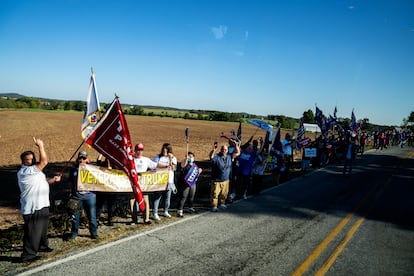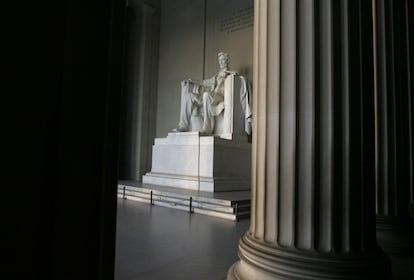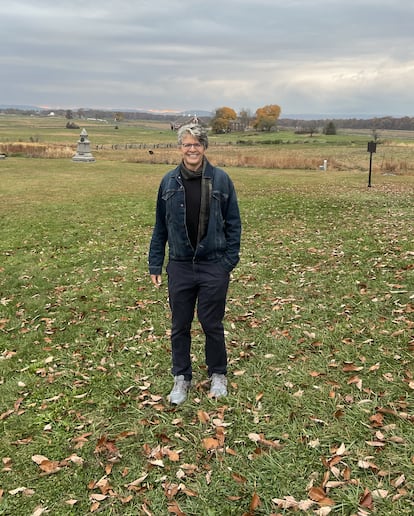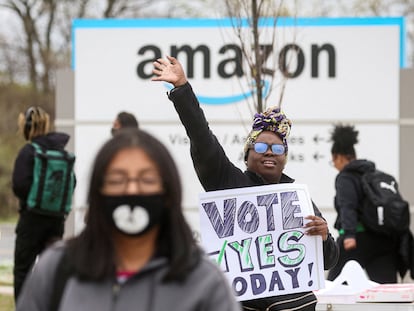Gettysburg’s lessons for American democracy
The vast majority of Americans believe that democracy is in danger, so EL PAÍS travelled to the site of the bloodiest battle of the Civil War in search of answers about how to protect it


The fall colors make for beautiful views in Gettysburg, Pennsylvania. Amid the tranquillity of the countryside and the endless fields and trees, you’d hardly be able to tell that this is where the bloodiest battle of the American Civil War (1861-65) was fought.
It’s raining cats and dogs on Wednesday, October 26 but the Gettysburg Museum is packed. It receives more than a million visitors each year – most of them American – who come to see where the decisive engagement of the Civil War took place over three bloody days in July, 1863.
It is also where President Abraham Lincoln delivered his famous Gettysburg Address. In his speech, he honored the sacrifice of Union soldiers and dedicated the Gettysburg National Cemetery. The carnage caused an estimated 51,000 casualties among Union and Confederate troops. One quote from Lincoln’s speech – “never forget what they did here” – adorns plastic bags in the gift shop.
More than 150 years later we are less than two weeks away from the 2022 midterm elections, which will decide who will control the United States Congress. But questions surrounding the survival of America’s union and democracy remain more relevant than ever.
According to an October 20 survey conducted by the Pew Research Center, 70% of American citizens consider the future of democracy to be “a very important” factor when it comes to making their decision at the polls. This is second only to the country’s economic situation – 79% of voters are most concerned about financial issues.
Republicans and Democrats are both worried about the survival of the democratic system, but for different reasons. According to polls conducted by The New York Times and the Siena College Research Institute, Republican voters tend to view democracy’s woes as stemming from President Biden, mainstream media, the federal government’s bureaucracy and the mail-in option for elections. Much of this is based on Donald Trump’s claim that the 2020 election was stolen from him. Meanwhile, for voters who support the Democratic Party, Trump is the greatest threat to democracy, followed by the right-leaning Supreme Court and election deniers.
Around 300 Republican candidates for Congress refuse to acknowledge the legitimacy of the 2020 presidential elections. There are concerns that, following the 2022 midterms and the 2024 presidential elections, these politicians, along with local Republican officials across the country, will refuse to accept the results if the Democratic Party triumphs.
A recent report by international observers from the Organization for Security and Cooperation in Europe (OSCE) paints a bleak picture of the American midterms. There have been threats against elected officials, allegations of voter suppression in racialized communities, unchecked incidents of mass disinformation and ultra-aggressive language in ads and rallies.
The OSCE made the report public this week, after two armed individuals dressed in tactical gear were caught threatening early voters in Arizona. Also this week, three men who planned to kidnap the governor of Michigan in 2020 were finally convicted.
Tensions piqued on Friday, October 28, when Paul Pelosi – the husband of Nancy Pelosi, Speaker of the United States House of Representatives – was attacked with a hammer at his residence in San Francisco. The home invader and would-be assassin was searching for Speaker Pelosi.

Last Wednesday in Gettysburg served to confirm that – at least among many of the American tourists – democracy in the 21st century is still considered to be under threat.
Ryan, from Philadelphia, arrived at the battlefield with his father, who’s “a fan of that era.” When asked if he thought it was plausible that the United States would ever have a similar confrontation again, in which different internal groups would go to war against each other, he replied: “It could [happen]. Some things that are talked about here [in the museum] are similar to a lot of what we’re seeing today.”
Kimball – a history buff who travelled to Gettysburg from California – explained that he spends his free time studying documents from the years before the Southern states seceded from the Union in 1861. “I pray every day that things don’t get out of hand,” he sighed.
Dwayne – a young man from Montana – said that “we must end wokeness, or America will fall apart.” Linda, a retiree from Atlanta, brought her son to Gettysburg to “correct some misconceptions about slavery inherited from his Southern education.” While she doesn’t think a large-scale armed conflict will break out, she does fear small bursts of violence, “like on January 6.”
Barbara F. Walter – a professor of political science at the University of California, San Diego – is the author of a book titled How Civil Wars Start: And How To Stop Them. For three decades, she has studied what has pushed other countries – from El Salvador to Syria – into fratricidal conflicts.

Walter differentiates America’s current situation from the 1860s. “When talking about civil war, Americans immediately think of two uniformed battalions on a battlefield. The kind of civil war that is common in the 21st century is very different – especially if it happens in a country like the United States, with such a powerful military,” she said at an event in San Diego.
“This time, it would be guerrilla warfare, carried out by militias throughout the country. They would desperately avoid confrontations with the armed forces. They would instead target civilians, minorities and African-American churches. Most violence would be concentrated in urban areas: both government loyalists and opposition leaders would be assasinated,” Walter said.
After learning of the attack on Paul Pelosi, Walter posted one of her favorite sources on Twitter: the Insurgency Analysis Guide that the CIA published in 2012, designed to be a study manual on other countries. It reads: “The incipient phase [of the insurgency] is the most dangerous; the insurgents have made their presence felt through initial attacks, but they are still weak. They can [conduct] terrorist tactics, such as kidnappings, small bombings, assassinations and anonymous threats.” Walter noted that the attack on Pelosi was an example of that “early war.”
This whole thread is worth reading. Provides evidence that political violence is increasing. And highlights books about what we can do about it. Thank you @kathleen_belew! https://t.co/1AfgkY8nDT
— Barbara F Walter (@bfwalter) October 28, 2022
Peter Carmichael – a historian and the director of the Civil War Institute at Gettysburg College – doesn’t subscribe to this interpretation.
“Despite all the episodes of violence we see, we’re nowhere near a secession situation like we were back then [in the 1860s]. This is quite different. What is mobilizing some people to take up arms is the belief that the 2020 election was not legitimate. It’s very dangerous for Republican leaders to subscribe to such conspiracy theories,” he says.

Carmichael took EL PAÍS to one of the most emblematic places on the Gettysburg tour: the High Water Mark of the Rebellion Monument. This was the northernmost point that the Confederate Army ever reached and was arguably the South’s best chance at achieving victory over the North. While it would take two more years for General Robert E. Lee to surrender, this was where the turning point in the Civil War occured: Lee’s plan to invade the North and force an immediate end to the conflict failed with the Union victory at Gettysburg.
“We’re not on the verge of a new civil war,” Carmichael says. “The question of slavery was insoluble. But I don’t see anything insoluble in what confronts the two main political parties today… nothing can’t be fixed, as long as certain concessions are made.”
Tu suscripción se está usando en otro dispositivo
¿Quieres añadir otro usuario a tu suscripción?
Si continúas leyendo en este dispositivo, no se podrá leer en el otro.
FlechaTu suscripción se está usando en otro dispositivo y solo puedes acceder a EL PAÍS desde un dispositivo a la vez.
Si quieres compartir tu cuenta, cambia tu suscripción a la modalidad Premium, así podrás añadir otro usuario. Cada uno accederá con su propia cuenta de email, lo que os permitirá personalizar vuestra experiencia en EL PAÍS.
¿Tienes una suscripción de empresa? Accede aquí para contratar más cuentas.
En el caso de no saber quién está usando tu cuenta, te recomendamos cambiar tu contraseña aquí.
Si decides continuar compartiendo tu cuenta, este mensaje se mostrará en tu dispositivo y en el de la otra persona que está usando tu cuenta de forma indefinida, afectando a tu experiencia de lectura. Puedes consultar aquí los términos y condiciones de la suscripción digital.










































